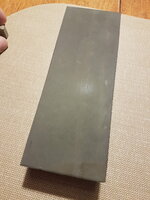First things first. Hello.
I gave a introduction to myself earlier today in the newbie check-in section of the forum. With a little more detail into the acquisition of this stone. If anyone is interested in reading it. I basically said it’s you folks fault. (JK)
My level of experience, and my knowledge base is zip, nada zero, when it comes to Jnats, except for the little information I’ve picked up from this site, and searching the internet recently.
I do however have a good bit of experience with and reasonably full sets of DMT, Chosera, Shapton, and a few Arks from over the years.
Now a couple of questions please.
After a few weeks of looking I finally found, ordered, and received this Jnat and nagura. I was all excited and about to seal these two with West systems GFlex marine epoxy.
#1
Can anyone think of a good reason NOT to use GFlex https://www.westsystem.com/specialty-epoxies/gflex-650-toughened-epoxy/ to seal the stones. The link is for product information purposes only.
I’ve use it exclusively when I’m looking for good penetration, adhesion, and flexibility for boat hull repairs. I also already have it in stock.
Even though I haven’t used the stone much yet. I wanted to get it sealed first while it was dry.
It is exactly what I was looking for to this point. Maybe I’m being a little too optimistic, but I try hard not to be a negative Nancy.
Unfortunately under closer examination I found the stone has a very small fracture across the top. When I run a razor across it, I don’t feel it, however I just have no idea what I should expect here, or if the fracture is of any consequence now or in the future.
#2 Should I seal it up, use it, and enjoy it ,throwing caution into the wind, or send it back?
Your opinions and feedback will be greatly appreciated!
Dave




I gave a introduction to myself earlier today in the newbie check-in section of the forum. With a little more detail into the acquisition of this stone. If anyone is interested in reading it. I basically said it’s you folks fault. (JK)
My level of experience, and my knowledge base is zip, nada zero, when it comes to Jnats, except for the little information I’ve picked up from this site, and searching the internet recently.
I do however have a good bit of experience with and reasonably full sets of DMT, Chosera, Shapton, and a few Arks from over the years.
Now a couple of questions please.
After a few weeks of looking I finally found, ordered, and received this Jnat and nagura. I was all excited and about to seal these two with West systems GFlex marine epoxy.
#1
Can anyone think of a good reason NOT to use GFlex https://www.westsystem.com/specialty-epoxies/gflex-650-toughened-epoxy/ to seal the stones. The link is for product information purposes only.
I’ve use it exclusively when I’m looking for good penetration, adhesion, and flexibility for boat hull repairs. I also already have it in stock.
Even though I haven’t used the stone much yet. I wanted to get it sealed first while it was dry.
It is exactly what I was looking for to this point. Maybe I’m being a little too optimistic, but I try hard not to be a negative Nancy.
Unfortunately under closer examination I found the stone has a very small fracture across the top. When I run a razor across it, I don’t feel it, however I just have no idea what I should expect here, or if the fracture is of any consequence now or in the future.
#2 Should I seal it up, use it, and enjoy it ,throwing caution into the wind, or send it back?
Your opinions and feedback will be greatly appreciated!
Dave


